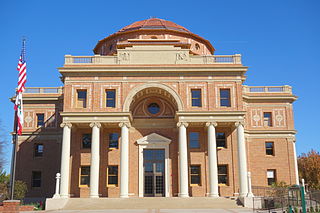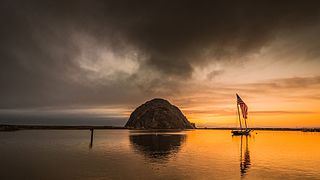
San Luis Obispo County, officially the County of San Luis Obispo, is a county on the Central Coast of California. As of the 2020 census, the population was 282,424. The county seat is San Luis Obispo.

Atascadero is a city in San Luis Obispo County, California, United States, located on U.S. Route 101. Atascadero is part of the San Luis Obispo-Paso Robles metropolitan statistical area, which encompasses the extents of the county. Atascadero is farther inland than most other cities in the county, and as a result, usually experiences warmer, drier summers, and cooler winters than other nearby cities such as San Luis Obispo and Pismo Beach. The main freeway through town is U.S. 101. The nearby State Routes 41 and 46 provide access to the Pacific Coast and the Central Valley of California.

Cambria is a seaside village in San Luis Obispo County, California, United States midway between San Francisco and Los Angeles along California State Route 1. The name Cambria, chosen in 1869, is the Latin name for Wales. Cambria is situated amidst Monterey pines in one of only three such native forests. The town previously had gone by the names of Slabtown, Rosaville, San Simeon, and Santa Rosa.

Morro Bay is a seaside city in San Luis Obispo County, California. Located on the Central Coast of California, the city population was 10,757 as of the 2020 census, up from 10,234 at the 2010 census. The town overlooks Morro Bay, a natural embayment with an all-weather small craft commercial and recreational harbor.

San Luis Obispo is a city and county seat of San Luis Obispo County, in the U.S. state of California. Located on the Central Coast of California, San Luis Obispo is roughly halfway between the San Francisco Bay Area in the north and Greater Los Angeles in the south. The population was 47,063 at the 2020 census.

Baywood-Los Osos is an unincorporated community in western San Luis Obispo County, California. The population was 14,351 in the 2000 census. It includes the communities of Los Osos, which is located near Morro Bay, Baywood Park, and the former community of Cuesta-by-the-Sea.

The Central Coast is an area of California, roughly spanning the coastal region between Point Mugu and Monterey Bay. It lies northwest of Los Angeles and south of the San Francisco Bay Area, and includes the rugged, rural, and sparsely populated stretch of coastline known as Big Sur.

San Simeon is a village and Census-designated place on the Pacific coast of San Luis Obispo County, California, United States. Its position along State Route 1 is about halfway between Los Angeles and San Francisco, each of those cities being roughly 230 miles (370 km) away. A key feature of the area is Hearst Castle, a hilltop mansion built for William Randolph Hearst in the early 20th century that is now a tourist attraction. The area is also home to a large northern elephant seal rookery, known as the Piedras Blancas rookery, located 7 miles (11 km) north of San Simeon on Highway 1.

Morro Bay State Park is a state park on the Morro Bay lagoon, in western San Luis Obispo County, on the Central Coast of California. On the lagoon's northeastern and eastern edges in the park, there are saltwater and brackish marshes that support thriving bird populations.

Morro Rock is a volcanic plug in Morro Bay, California, on the Pacific Coast at the entrance to Morro Bay harbor. A causeway connects it with the shore, making it a tied island. The rock is protected as the Morro Rock State Preserve.

Estero Bay is a bay located on the Pacific Coast in San Luis Obispo County, central California. It is about 15 miles (24 km) from its south end at Point Buchon/Montana de Oro State Park, to its north end at Point Estero, which is about 5 miles (8 km) northwest of Cayucos. It is indented about 5 miles (8 km) into the California coast.

Montaña de Oro is a state park in Central Coastal California, six miles southwest of Morro Bay and two miles south of Los Osos.

The Morro Bay kangaroo rat(Dipodomys heermanni morroensis), is an endagered rodent in the Heteromyidae family and endemic to San Luis Obispo County, California. The species is the smallest subspecies of the Heermann's kangaroo.

Los Osos Oaks State Natural Reserve is a California State Park in western San Luis Obispo County, in the Central Coast of California region. It preserves centuries-old coast live oaks growing atop relict sand dunes. It is located in the Los Osos Valley between San Luis Obispo and Baywood Park-Los Osos, just outside the town of Los Osos. The 85-acre (34 ha) park was established in 1972.

The Los Osos Valley is a valley within San Luis Obispo County, in the Central Coast of California region.
Morro Creek is a coastal stream in San Luis Obispo County, in the central region of the U.S. state of California. The watercourse flows from the Santa Lucia Mountains to discharge into the Pacific Ocean, at its mouth on Estero Bay, near the city of Morro Bay.

The Elfin Forest Natural Area is a nature preserve protecting a unique plant community in Los Osos-Baywood Park, San Luis Obispo County, central California. It consists of prehistoric sand dunes, rising 150 feet (46 m) above southern Morro Bay, on the north of Los Osos-Baywood Park.
Los Osos Back Bay is a prehistoric Chumash archaeological site in the Los Osos Valley, near the coast in San Luis Obispo County, California.
San Luis Coastal Unified School District is a school district primarily in San Luis Obispo, California.

Amphibious Training Base Morro Bay also called Camp Morro Bay and Morro Bay Section Base was a US Navy training base for amphibious beach assault during World War II. The base opened in 1941 to train troops for the Pacific theater of operations' island leapfrogging using landing craft and LCVP. The base was located in Morro Bay, California in San Luis Obispo County. The base was on 250 acres (100 ha) of leased land. Ships for the base were based at the Avila's Port San Luis in San Luis Bay. Which was also leased with the yacht club and its warehouse. Added to the leased land was: two piers, mess hall, gallon water storage tanks, roads, buildings, garages, and ammo storage area. The Navy also extended the bay's breakwater. A wooden trestle bridge was built to get to the nearby sandspit, the bridge was removed in 1946 and some pillars still remain. The near Estero Bay was the site of training assault also, by the Navy, US Army, US Marine Corps and United States Coast Guard also taking over the unused vacation hotel there. Nearby United States Army Air Corps fields had fighter aircraft fire flour shot to make the training more real. Up to 175 landing craft were at the base and 16,000 troops a day trained. In the base and in nearby Los Osos and Baywood live fire bombing, machine gun, bazookas, and flamethrowers were used for training. The training ended on 31 October 1945 and the site is now a Duke Energy power plant built in 1955, site of three large smoke stacks. North of the former base in the notable Morro Rock. Avila Beach was also a Union Oil plant with many oil storage tanks, use for Navy ships.
























